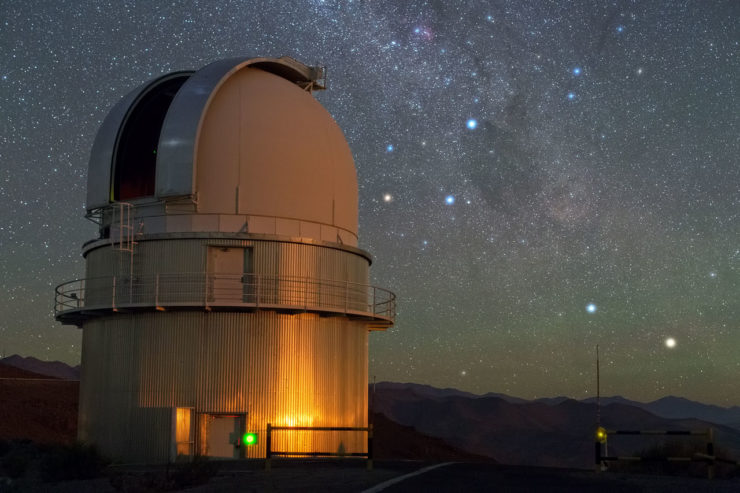Alpha Centauri is, as you know, currently the closest star system to the Solar System. It is a triple star system, comprising Alpha Centauri A (a G2 V star slightly brighter and slightly more massive than the Sun), Alpha Centauri B (a K1 V slightly dimmer and slightly less massive than the Sun), and Alpha Centauri C (a low-mass, dim red dwarf which is also known as Proxima Centauri).
Proxima is strongly believed to be orbited by a world in the habitable zone. According to Wagner, K., Boehle, A., Pathak, P. et al1 in Imaging low-mass planets within the habitable zone of α Centauri, Alpha Centauri A may also boast a world in its habitable zone.
To quote:
In other words, C1 is not a known systematic artifact, and is consistent with being either a Neptune-to-Saturn-sized planet or an exozodiacal dust disk.
Admittedly, this does not narrow down the nature of C1 as narrowly as one would like. And the low end of the size estimate is still not exactly Earth Two. Still, the paper does not rule other, perhaps more Terrestrial worlds in the Alpha Centauri A system’s Goldilocks Zone. Or conveniently sized moons orbiting C1. After all, the Moon is roughly one percent the mass of Earth and Charon is a mighty ten percent of the mass of Pluto. In any case, it’s interesting to see yet another “Here there may be dragons” area on our maps beginning to be sketched in with actual data.
Not only is Alpha Centauri the nearest system to ours, two of its three stars are at least somewhat sunlike. Unsurprisingly, science fiction long ago saw the narrative potential offered by Alpha Centauri. Consider these five examples.
Alpha Centauri or Die! by Leigh Bracket (1963)
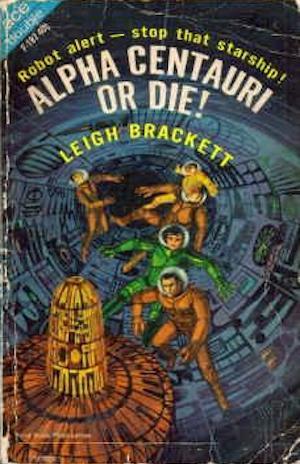
The Solar System is firmly under the thumb of an authoritarian government determined to bring peace with a stomping boot. While every reasonable need is filled, daily life is regimented and the space lanes are plied solely by robot ships. Not everyone is happy with this arrangement. The malcontents include among them men like Kirby—men with the skills to crew a one-way flight to Alpha Centauri and its known habitable world.
There are, of course, one or two catches. The State forbids such flights. The same robot ships that travel between the solar planets could follow the refugees to Alpha Centauri. Most importantly, there is a reason the Solar System’s authoritarian have never tried to annex Alpha Centauri. Alpha Centauri’s world may not be home to someone but it is definitely home to something. How it will react to invaders remains to be seen….
***
Flight of Exiles by Ben Bova (1972)

Half a century after fleeing Earth, the retrofitted space station-turned-unnamed generation ship approaches Alpha Centauri. The original scientists who set out on this journey knew that the system had a planet that might be habitable. Their children discover a world more habitable than most of the worlds back in the Solar System, but one that (alas!) falls far short of Earth itself. Surface gravity is a third higher than Earth’s and the atmosphere has dangerously high levels of nitric oxides and sulfur oxides.
The ship has two equally unsatisfactory options. The refugees could simply continue on their way, hoping to reach a world more to their taste before their ship falls apart. Alternatively, they could use their prodigious biotechnical skills to create beings adapted to Alpha Centauri’s world. If they do, will they see such creations as their children? That’s an open question.
There is not much time to decide. At least one crewmember is willing to kill to ensure the ship makes the correct choice.
***
The Phoenix Legacy by M. K. Wren (1981)
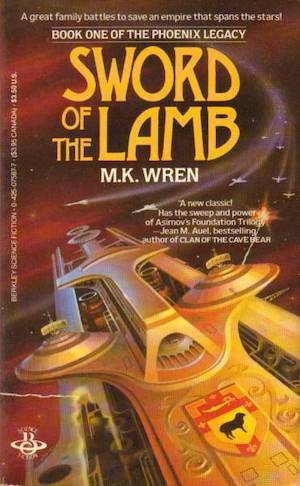
(Sword of the Lamb, Shadow of the Swan, and House of the Wolf)
The civilization that rose out of the ruins of ours is wealthy and technically advanced. Thus, the worlds of the Concord include not just the worlds of our Solar System, but also Alpha Centauri A’s Pollux and Castor (the first of which is habitable). The catch is that the Concord is a caste-ridden society which generates wealth for thousands of Elites at the cost of misery for billions of Bonds.
Some Elite admit this is unjust. They are, however, painfully aware that the last attempt to reform society ended in a civil war that killed a billion people. How to reform the system without losing privilege, and without risk? It’s quite the puzzler. But the clock is ticking for the Concord, because the rebel Phoenix has technology the Concord lacks and is determined to free the Bonds.
***
Voyage from Yesteryear by James P. Hogan (1982)
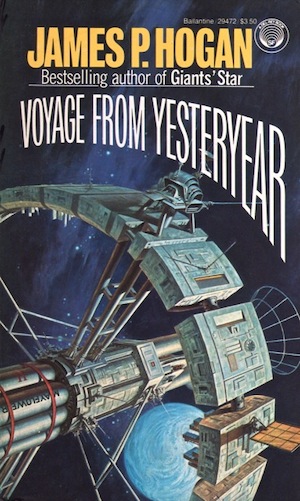
Determined to ensure that humanity survives the nuclear war that is sure to come, North American Space Development Organization and its Asian partners send off the SP3 interstellar probe. The probe carries with it encoded genetic information and machines designed to create and raise human children. The gamble pays off in spades: not only are humans established on Alpha Centauri A’s garden world Chiron, but the venture also founds a post-scarcity utopia.
Back on Earth, humanity digs out from the radioactive rubble and rebuilds civilization. North America’s New Order provides Americans with a firm guiding hand and freedom from democratic excesses. The New Order covets Chiron. To prevent its Terrestrial rivals from conquering Chiron first, the Americans dispatch a crewed starship on a generation-long mission.
And if the Chironians object? The New Order knows how to crush dissent.
***
Encounter With Tiber by John Barnes and Buzz Aldrin (1996)
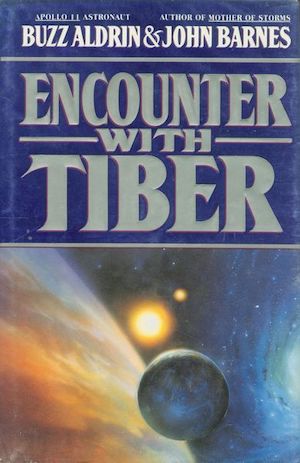
In this collaboration between Barnes and former astronaut Aldrin, the once verdant garden world humans call Tiber is a moon of a gas giant orbiting Alpha Centauri A. When the human starship Tenacity launches towards Tiber in 2069, it does so with reasonable confidence that Tiber once was life-bearing. After all, the Solar System received a message from Tiber.
In fact, Tiberians met humans long before humans mastered the art of interstellar flight. When the first Tiberian expeditions reached the Solar System in the 73rd century B.C., humans lived in Stone Age tribes. The Earth and its inhabitants were ideal from the Tiberian perspective. Stone age Terrestrials could hardly prevent the Tiberians from taking the Earth for their desperately needed new home. Victory is assured!
And yet, the fact that Earth is not and has never been a Tiberian colony suggests that something did confound the aliens. The answer to this mystery is revealed in surviving Tiberian documents….
***
Obviously, five books represent only a very small fraction of the books that have been written using Alpha Centauri A as a setting or destination. Feel free to make the case for your favourites in the comments below.
In the words of Wikipedia editor TexasAndroid, prolific book reviewer and perennial Darwin Award nominee James Davis Nicoll is of “questionable notability.” His work has appeared in Publishers Weekly and Romantic Times as well as on his own websites, James Nicoll Reviews and Young People Read Old SFF(where he is assisted by editor Karen Lofstrom and web person Adrienne L. Travis). He is a four-time finalist for the Best Fan Writer Hugo Award and is surprisingly flammable.
[1]Included in the et al: K. Wagner, A. Boehle, P. Pathak, M. Kasper, R. Arsenault, G. Jakob, U. Käufl, S. Leveratto, A.-L. Maire, E. Pantin, R. Siebenmorgen, G. Zins, O. Absil, N. Ageorges, D. Apai, A. Carlotti, É. Choquet, C. Delacroix, K. Dohlen, P. Duhoux, P. Forsberg, E. Fuenteseca, S. Gutruf, O. Guyon, E. Huby, D. Kampf, M. Karlsson, P. Kervella, J.-P. Kirchbauer, P. Klupar, J. Kolb, D. Mawet, M. N’Diaye, G. Orban de Xivry, S. P. Quanz, A. Reutlinger, G. Ruane, M. Riquelme, C. Soenke, M. Sterzik, A. Vigan & T. de Zeeuw.










